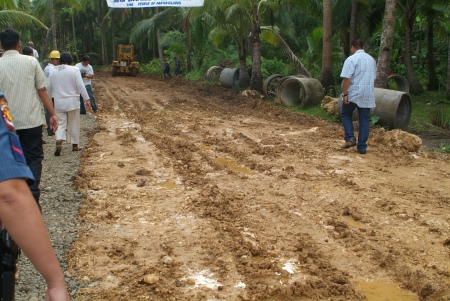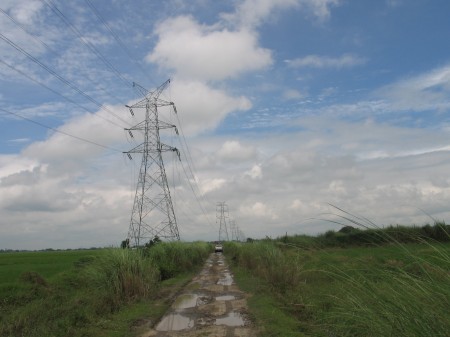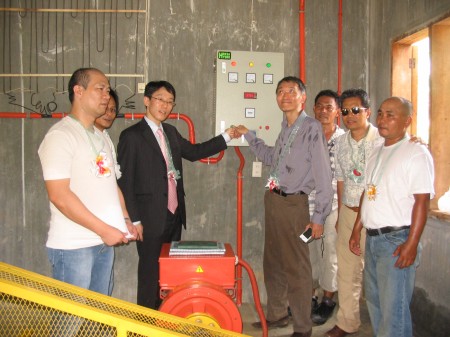
The Maydolong farm-to-market road being constructed under INFRES
(Published in the Philippine Daily Inquirer issue of 1 December 2008)
Borongan, Eastern Samar – Eastern Samar used to be widely known as a province with one of the highest poverty rates in the country. But Ben Evardone, its two-term governor, has led the province out of the so-called Club of 20 poorest provinces. From being the 19th poorest province in 2000 from the bottom with a 45.9% poverty incidence estimate in the National Statistical Coordination Board’s Ranking, it improved to 36th place out of 79 provinces in 2003, registering 33.9% or an 11% improvement during that three-year period.
He shares the credit with his predecessors whose development projects he continued with renewed vigor. He also focused on education and social services, building infrastructure and creating livelihood, and is pushing for a slice of the booming tourism industry. He successfully persuaded major airlines to fly to his province, despite its being located along the eastern seaboard, right smack into typhoons coming from the Pacific Ocean. Waves are strong enough even in a non-typhoon season, that it has become a popular destination among surfers, specifically in Calicoan island in Guiuan town. It is also in that town, in Homonhon island, where Ferdinand Magellan, credited for having discovered the Philippines, first set foot on March 16, 1521.
The national government has earmarked P1 billion for roads and infrastructure in the next two years for this province, once notorious for the poor conditions of its highways. The construction of new farm-to-market roads in the hinterlands have dramatically increased farmers’ income by at least 30 percent with their newfound access to markets, and the governor is grateful to multilateral agencies like the Asian Development Bank (ADB) for the assistance.
Eastern Samar is the recipient of 2 ADB loans. Under the Agrarian Reform Communities Project, P127 million worth of farm-to-market roads were constructed or rehabilitated in Borongan, Llorente, San Julian, Maydolong, Hernani, General MacArthur, and Quinapondan. Under the project, up to P30 million was made available to each municipality to build roads, bridges, communal irrigation, drinking water supply and other basic infrastructure. The beneficiaries were poor landless farmers and small-scale cultivators who were part of agrarian reform communities. In addition, the ARCP provided land survey, agribusiness and community development assistance, and promoted comprehensive bottom-up community participation. For the rural infrastructure and other sub-projects, the local government unit also contributed counterpart funding as its share. The Department of Agrarian Reform was the Executing Agency of the recently completed project. Its successful rating from ADB has led to the approval of an ARCP phase 2, targeting 150,000 poor farmers mostly in the southern Philippines.
Ongoing in the province is another ADB loan called the Infrastructure for Rural Productivity Enhancement Sector project (InfRES) with the Department of Agriculture as the executing agency. Some P309.9 million worth of farm to market roads and bridges are being constructed or rehabilitated in Arteche, Balangkayan, Can-Avid, Dolores, Hernani, Maslog, Maydolong, and Sulat.
InfRES benefits local government units in Southern Tagalog (Region IV-B), Bicol, Eastern Visayas, and Mindanao where over 70 percent of poor Filipinos live. Instead of the national government imposing the project on them, LGUs are empowered to identify and develop projects based on their own design and implementation process. Half of the project cost is funded by the ADB loan while the national and local governments and beneficiaries shoulder the other half, in cash or in kind.
The project has the long-term developmental goal of increasing rural income favoring poor areas with high agricultural potential by providing roads, communal irrigation systems, and drinking water on the premise that a major cause of poverty is largely due to inadequate rural infrastructure. With irrigation improvements alone, annual income from crop production can increase by at least 80 percent. Some 700,000 people from farm and non-farm households are the beneficiaries.
“InfRES will revolutionalize the rural areas,” says Governor Evardone. “Before, just to go to one barangay, you need to pass 2 municipalities. Now, no more since 15 farflung barangays will now be connected,” he added. It will increase trade and industry and entrepreneurship among the affected communities and shorten travel time and reduce transportation costs.
InfRES is particularly appealing to LGUs since they only finance part of the project cost as their counterpart. Maydolong Mayor Daniel Baldono has already his own 14-kilometer FMR under construction. With only P6 million available for development projects in his municipality, he is seeking another InfRES subproject, a potable water supply. “How can I have projects with only that amount if I will not seek additional sources from outside?” he said.
In Dolores town, the FMR is much-delayed due to a change in contractors, bad weather, and heavy rains but the lady mayor is determined to finish it because of its impact on her town. “We have very very rich ricelands and that will be the key to the development of Eastern Samar. We have over 5,300 irrigable lands; we have the biggest irrigation project in region 8,” says Dolores Mayor Emiliana Villacarillo.
Spanning 28.5 kilometers, the P100 million road is a combination of newly-opened and rehabilitated components that will traverse 13 barangays, benefiting two-thirds of the town’s 46,000 population. Each barangay has been trained to maintain the portion of the road in their area to ensure the sustainability of the infrastructure.
“The InfRES project in Dolores will connect from the main highway to the rice granary of Eastern Samar because they are second to Quinapondan in producing the rice production in the province. So the InfRES project in Dolores is very critical,” says Governor Evardone.
 , Arnold Jocosol (3rd from right) with Governor Evardone (2nd from left) who is flanked by 2 members of the ADB Board of Directors.
, Arnold Jocosol (3rd from right) with Governor Evardone (2nd from left) who is flanked by 2 members of the ADB Board of Directors.
Arnold Jocosol, 38, a farmer in Dolores, related that he can only transport his goods on a carabao and there was no road to speak of. Today, a road is being constructed right in front of his home and he knows it will be a big help to his family. “I did not even dream there would be a road here,” he told a visiting group of ADB Board members in the local dialect. But after the road, he says he hopes he would also have capital for other activities that he would like to pursue like a piggery and a mini-store.
“In most of the barangays that did not have roads before, they can transport their products now from their barangay to the market,” says Mayor Javier Zacate of Sulat who just had a ground-breaking of his own 17-kilometer FMR under InfRES.
But even if InfRES is still being implemented, LGUs who were not able to avail of the project are already submitting their own project proposals for InfRES phase 2. And in Eastern Samar, mayors who were not able to avail of the project are ribbing their fellow mayors who already have InfRES projects to give way so that they too can benefit from the project, while the Governor amusedly looks on.
In the last NSCB Poverty Statistics ranking in 2006, Eastern Samar teetered close to entering the Club of 20 poorest provinces again, ranking 23rd in poverty incidence, as the number of families under the poverty line fell to 42.7% from 33.9 percent in 2003. The Governor knows only too well that he and his fellow Estehanons still have a lot of work to do in the poverty reduction front to sustain their gains and not fall behind again.




